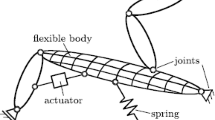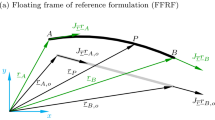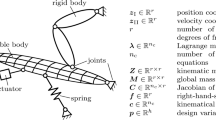Abstract
This work discusses a sensitivity information methodology for input optimization of flexible multibody systems. Mechanisms often need to perform desired motions, and especially in the case of underactuated flexible systems, the required drive motion or torque are nontrivial to determine. In this work we present an optimization approach which exploits the Adjoint Variable Method (AVM) in combination with the Flexible Natural Coordinates Formulation (FNCF) for obtaining the sensitivity information. The Adjoint Variable Method has the advantage of obtaining accurate sensitivity information at a computational cost that is relatively independent of the number of model parameters. FNCF combines the advantageous properties of the Floating Frame of Reference Formulation (FFRF) and the Generalized Component Mode Synthesis (GCMS) methods for which the equations of motion are characterized by a constant mass and stiffness matrix, and quadratic constraint equations. This work shows how the specific structure of the motion equations obtained through FNCF reduces the complexity of the Adjoint Variable Method as the required simulation derivatives for input optimization can be readily obtained and are of limited order. The approach is illustrated for an input optimization case on a flexible slider–crank multibody model, where the objective is to construct an input torque signal such that the crank’s angular velocity matches a predefined reference signal.






Similar content being viewed by others
Notes
\(\widetilde{\pmb \omega} = \widetilde{ \begin{bmatrix} \omega _{1}& \omega _{2}&\omega _{3} \end{bmatrix}} ^{\mathrm{T}}= \begin{bmatrix} 0& -\omega _{3} & \omega _{2} \\ \omega _{3}& 0 & -\omega _{1} \\ -\omega _{2}& \omega _{1} & 0 \end{bmatrix} \)
References
Bastos, G., Seifried, R., Brüls, O.: Inverse dynamics of serial and parallel underactuated multibody systems using a DAE optimal control approach. Multibody Syst. Dyn. 30(3), 359–376 (2013). https://doi.org/10.1007/s11044-013-9361-z
Bertolazzi, E., Biral, F., Da Lio, M.: Symbolic–numeric indirect method for solving optimal control problems for large multibody systems. Multibody Syst. Dyn. 2005(13), 233–252 (2005). https://doi.org/10.1007/S11044-005-3987-4. 2. https://link.springer.com/article/10.1007/s11044-005-3987-4
Bestle, D.: Optimization of automotive systems. In: Concurrent Engineering: Tools and Technologies for Mechanical System Design, pp. 671–683. Springer, Berlin Heidelberg, Berlin, Heidelberg (1993). https://doi.org/10.1007/978-3-642-78119-3_25
Bischof, C.H.: On the automatic differentiation of computer programs and an application to multibody systems. In: Solid Mechanics and Its Applications, pp. 41–48. Springer, Dordrecht (1996). https://doi.org/10.1007/978-94-009-0153-7_6
Callejo, A., Sonneville, V., Bauchau, O.A.: Discrete adjoint method for the sensitivity analysis of flexible multibody systems. J. Comput. Nonlinear Dyn. 14(2), 1–11 (2019). https://doi.org/10.1115/1.4041237
Craig, R., Bampton, M.: Coupling of substructures for dynamic analyses. AIAA J. 6(7), 1313–1319 (1968). https://doi.org/10.2514/3.4741. https://hal.archives-ouvertes.fr/hal-01537654
Craig, R.R., Kurdila, A.J.: Fundamentals of Structural Dynamics, 2nd edn. Wiley, New York (2006)
Haug, E.J., Arora, J.S.: Design sensitivity analysis of elastic mechanical systems. Comput. Methods Appl. Mech. Eng. 15(1), 35–62 (1978)
Eichmeir, P., Lauß, T., Oberpeilsteiner, S., Nachbagauer, K., Steiner, W.: The adjoint method for time-optimal control problems. J. Comput. Nonlinear Dyn. 16(2), 1–12 (2021). https://doi.org/10.1115/1.4048808
Gerstmayr, J., Ambrósio, J.A.C.: Component mode synthesis with constant mass and stiffness matrices applied to flexible multibody systems. Int. J. Numer. Methods Eng. 73(11), 1518–1546 (2008). https://doi.org/10.1002/nme.2133
Haug, E.J.: Design sensitivity analysis of dynamic systems. In: Mota, S.C.A. (ed.) Computer Aided Optimal Design: Structural and Mechanical Systems, pp. 705–755. Springer, Berlin (1987). https://doi.org/10.1007/978-3-642-83051-8_22
Haug, E.J., Wehage, R.A., Mani, N.K.: Design sensitivity analysis of large-scale constrained dynamic mechanical systems. J. Mech. Des., Trans. ASME 106(2), 156–162 (1984). https://doi.org/10.1115/1.3258573
Hurty, W.C.: Dynamic analysis of structural systems using component modes. AIAA J. 3(4), 678–685 (1965). https://doi.org/10.2514/3.2947
de Jalon, J.G., Bayo, E.: Kinematic and Dynamic Simulation of Multibody Systems. Springer, New York (1994), mechanical edn.
Jay, L.O., Negrut, D.A.N.: Extensions of the HHT-alpha method to DAEs in mechanics. Electron. Trans. Numer. Anal. 26, 190–208 (2007)
Jensen, J.S., Nakshatrala, P.B., Tortorelli, D.A.: On the consistency of adjoint sensitivity analysis for structural optimization of linear dynamic problems. Struct. Multidiscip. Optim. 49(5), 831–837 (2014). https://doi.org/10.1007/s00158-013-1024-4
Lauß, D.I.T.: Optimal Control of Multibody Systems Using the Adjoint Variable Approach, July (2019)
Lauß, T., Leitner, P., Oberpeilsteiner, S., Steiner, W.: Energy optimal manipulation of an industrial robot. In: ECCOMAS Thematic Conference on Multibody Dynamics, June 29-July 2 Barcelona, Spain, vol. 43, pp. 1–10 (2015)
Lauß, T., Oberpeilsteiner, S., Steiner, W., Nachbagauer, K.: The discrete adjoint gradient computation for optimization problems in multibody dynamics. J. Comput. Nonlinear Dyn. 12(3), 1–10 (2017). https://doi.org/10.1115/1.4035197
Negrut, D., Ottarsson, G., Rampalli, R., Sajdak, A.: On the use of the HHT method in the context of index 3 differential algebraic equations of multibody dynamics. In: Proceedings of the ASME International Design Engineering Technical Conferences and Computers and Information in Engineering Conference – DETC2005, vol. 6A, pp. 207–218 (2005). https://doi.org/10.1115/detc2005-85096
Negrut, D., Rampalli, R., Ottarsson, G., Sajdak, A.: On an implementation of the Hilber–Hughes–Taylor method in the context of index 3 differential-algebraic equations of multibody dynamics (DETC2005-85096). J. Comput. Nonlinear Dyn. 2(1), 73–85 (2007). https://doi.org/10.1115/1.2389231
Oberpeilsteiner, S., Lauss, T., Nachbagauer, K., Steiner, W.: Optimal input design for multibody systems by using an extended adjoint approach. Multibody Syst. Dyn. 40(1), 43–54 (2017). https://doi.org/10.1007/s11044-016-9541-8
Pechstein, A., Reischl, D., Gerstmayr, J.: A generalized component mode synthesis approach for flexible multibody systems with a constant mass matrix. J. Comput. Nonlinear Dyn. 8(1), 011019 (2012). https://doi.org/10.1115/1.4007191. http://computationalnonlinear.asmedigitalcollection.asme.org/article.aspx?doi=10.1115/1.4007191
Seifried, R.: Two approaches for feedforward control and optimal design of underactuated multibody systems. Multibody Syst. Dyn. 27(1), 75–93 (2012). https://doi.org/10.1007/s11044-011-9261-z
Seifried, R.: Dynamics of Underactuated Multibody Systems. Modeling, Control and Optimal Design, vol. 1. Springer, Berlin (2014). https://doi.org/10.1002/pamm.200910034
Seifried, R., Burkhardt, M., Held, A.: Trajectory control of serial and parallel flexible manipulators using model inversion. Comput. Methods Appl. Sci. 28, 53–75 (2013). https://doi.org/10.1007/978-94-007-5404-1_3/FIGURES/8. https://link.springer.com/chapter/10.1007/978-94-007-5404-1_3
Shabana, A.A.: Dynamics of Multibody Systems, vol. 9781107042 (2013). https://doi.org/10.1017/CBO9781107337213
Vanpaemel, S.: Sensitivity analysis of flexible multibody systems. PhD thesis, KU, Leuven (2022). With applications in parameter, topology and input optimization
Vanpaemel, S., Naets, F., Vermaut, M., Desmet, W.: Parameter identification on flexible multibody models using the adjoint variable method and flexible natural coordinate formulation. J. Comput. Nonlinear Dyn. 15(7), 071006 (2020). https://doi.org/10.1115/1.4047086. http://asmedigitalcollection.asme.org/computationalnonlinear/article-pdf/15/7/071006/6536461/cnd_015_07_071006.pdf
Vermaut, M., Naets, F., Desmet, W.: A flexible natural coordinates formulation (FNCF) for the efficient simulation of small-deformation multibody systems. Int. J. Numer. Methods Eng. 115(11), 1353–1370 (2018). https://doi.org/10.1002/nme.5847
Acknowledgements
Internal Funds KU Leuven are gratefully acknowledged for their support. This research was partially supported by Flanders Make, the strategic research center for the manufacturing industry.
Author information
Authors and Affiliations
Corresponding author
Ethics declarations
Competing Interests
The authors declare no competing interests.
Additional information
Publisher’s Note
Springer Nature remains neutral with regard to jurisdictional claims in published maps and institutional affiliations.
Rights and permissions
Springer Nature or its licensor (e.g. a society or other partner) holds exclusive rights to this article under a publishing agreement with the author(s) or other rightsholder(s); author self-archiving of the accepted manuscript version of this article is solely governed by the terms of such publishing agreement and applicable law.
About this article
Cite this article
Vanpaemel, S., Vermaut, M., Desmet, W. et al. Input optimization for flexible multibody systems using the adjoint variable method and the flexible natural coordinates formulation. Multibody Syst Dyn 57, 259–277 (2023). https://doi.org/10.1007/s11044-023-09874-z
Received:
Accepted:
Published:
Issue Date:
DOI: https://doi.org/10.1007/s11044-023-09874-z




